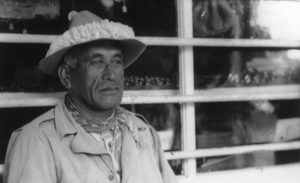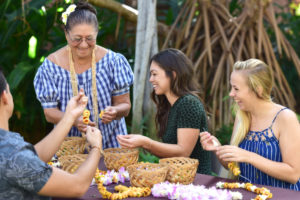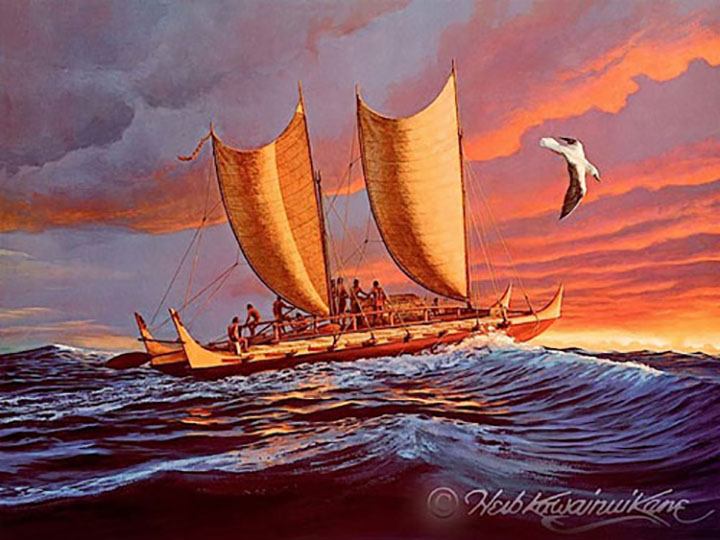
This artwork by Herb Kane shows the voyaging canoe Hokulea. Photo: Honolulu Star-Advertiser.
On Saturday, June 17, 2017 a dream came true for many thousands of people in Hawaii and around the world. For the very first time, a Polynesian voyaging canoe has circumnavigated the globe. After three years of sailing, the sea vessel Hokulea was welcomed home in Honolulu, Hawaii.
The story of Hawaiian sailing canoes started about 2,000 years ago with voyagers from far distant islands making landfall on the South Point of what we now call Hawaii’s Big Island. The travelers chiseled the tale of their oceanic voyages into the broad surfaces of cooled lava rocks. The stone etchings from hundreds and thousands of years ago leave a clear record of their migration story, even without a written language.
Artist Herb Kane Puts Paint to Canvas and Brings Canoes to Life
Hawaii artist Herb Kawainui Kane had a passion for the South Pacific. He was raised in Waipio Valley on the Big Island. After time in the U.S. Navy, he taught art in Chicago and then came home to South Kona. Canoes depicted in the ancient rock art became a reality as the images of Polynesian voyaging canoes filled his paintings and his life.
In the early 1970s, Kane had an aspiration and wrote “if a voyaging canoe were built and sailed today, it would function as a cultural catalyst and inspire the revival of almost-forgotten aspects of Hawaiian life.” And so, together with a small group of others, Kane founded the Polynesian Voyaging Society. They designed and constructed Hokulea, the first Hawaiian voyaging canoe in hundreds of years. The name Hokulea come to Kane in a dream; it’s the name of a star over Hawaii. In 1975, Hokulea was launched for the first time, and Kane served as the first captain, sailing between the Hawaiian Islands and sharing Hokulea with the people of Hawaii prior to the first open ocean voyage.
Kane did indeed create a cultural catalyst. Hokulea did indeed become the rallying point for the Hawaiian Renaissance of the 1970s, revitalizing Hawaiian language, music, hula and, of course, the ancient art of wayfaring.
The Quiet Hero of the Voyaging World
The captain who moved the art of wayfinding to the top of the international collective knowledge, Nainoa Thompson, is the quiet hero of the voyaging world. He humbly credits Kane as “the father of the Hawaiian Renaissance.” He credits the first crews, and all the voyagers since, for making the dream a reality.
He credits Satawalese Master Navigator Mau Piailug for imparting the knowledge of wayfinding and for making long-distance, non-instrumental ocean navigation possible in Polynesian once again.
Thompson has often spoken of two voyagers that might surprise the hundreds of thousands of fans that follow the Worldwide Voyage. The first is a man named William Anders. In December of 1967, Anders was one of the three crew members, Borman, Lovell and Anders, taking a voyage of discovery. Apollo 8 took off for the moon. Sliding into a smaller spacecraft, Bill Anders orbited the moon, not knowing what was on the dark side or if he would be successful. He was.
Thompson always says of Anders, “I just want to thank him.”
His next hero is Colonel Lacy Veach, a Hawaii boy who decided he wanted to fly into space. And he did. Thompson’s story of his friend’s advice is simple. “We had successful voyages all across the Pacific,” says Thompson. “I wasn’t sure what should come next. I was talking to Lacy [via radio on the canoe in 1992] as he was orbiting over the Hawaiian islands. He said, ‘Do what I am doing; orbit the earth.’”
Over fifteen years later, Thompson has successfully navigated the Hokulea around the earth.
A Worldwide Voyage
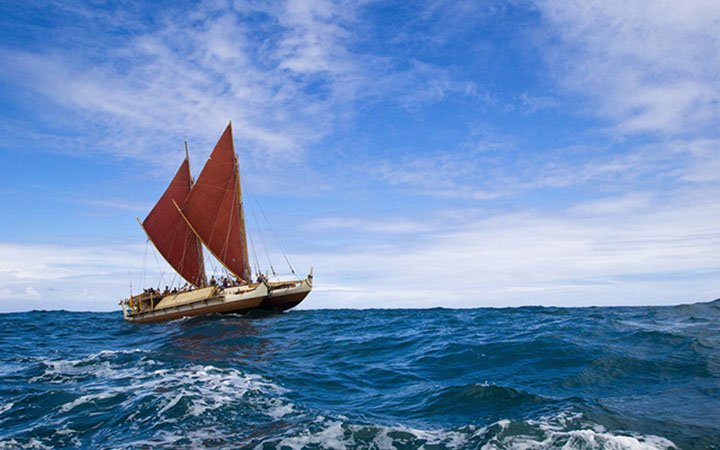
PHOTO COURTESY POLYNESIAN VOYAGING SOCIETY.
When the reports and photos began to roll across the pages of newspapers and magazines people were amazed. The Pamunkey Tribe in Newport News, Virginia never expected to see a voyaging canoe. Friends and relatives drove from Florida and Georgia to see for themselves. They went home to tell their neighbors and relatives about something that, to land-locked mainlanders, seemed like a Disney movie.
Watching the evening news in Hawaii as “our” canoe sailed past the Washington Monument was all the grade school students in Hawaii could talk about. One grade school teacher said she watched it “slowly became real” to her students and pride was “off the charts.”
The facts and figures of the Worldwide Voyage are mind-boggling. 46,000 nautical miles trailed, more than 150 ports visited in over 23 countries and territories. Eight UNESCO World Heritage Marine sites visited. Two hundred and forty-five participating crew members. Over 200 formal and informal educators participated as crew members on the Worldwide Voyage and statewide sail.
The name of the voyage, Malama Honua, means to care for the world. The voyage was as much about caring for our planet as it was about caring for our planet’s people. Thompson speaks of discovering a worldwide culture of “compassion and kindness” that transcends race, geography and political systems.
Could Kane, who passed in 2011, have perceived the impact Hokulea would have on the world? Could the voyagers who first set foot on Hawaii have dreamed their descendants would one day sail the globe?
Hokulea Homecoming – Notes as of June 14, 2017
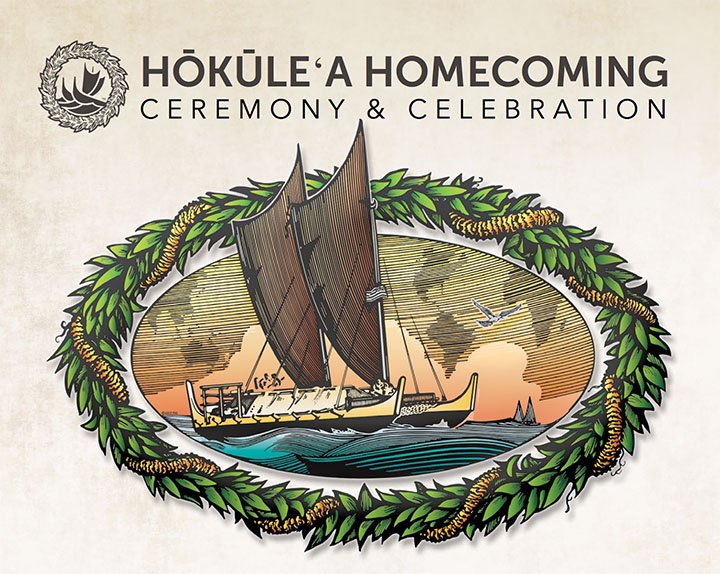
June 17th, 2017 is the day of celebration. Canoes from every island will gather. When Malama Honua began some of the Hawaii islands didn’t have a voyaging canoe or they had one under construction. Now they will gather their fully operational canoes, along with canoes from other Pacific nations, to celebrate. Each carries the message of Malama Honua. As the Ocean Elders have repeated over and over, the need for a clean ocean constantly grows. If we as the protectors of islands and nations do not fight back our children and their children will have no future.
The task will continue. The voyage is not over. For the next year, Hokulea will continue to sail the Hawaiian Islands and continue to inspire new voyagers to wayfind the future.
Read more about Hokulea’s worldwide journey at www.staradvertiser.com/hokulea.



